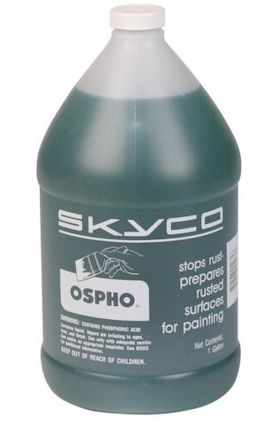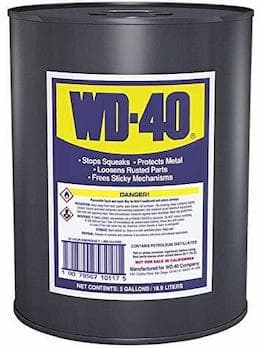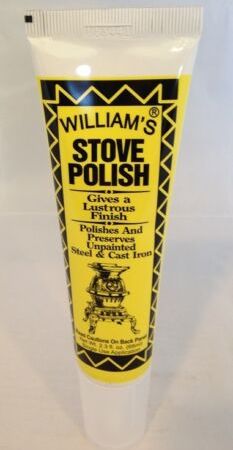
-----
Restoring rusty cast iron wood stove, painting it
Quickstart: For restoring a cast iron wood stove with rust, steel wool is the best choice. But if the rust is too bad for that, start with wire brushes, on a drill if necessary. Sandblasting is okay if you have the equipment, but expensive if you don't. Burn off bolts if WD-40 won't loosen them.
Stove Polish
⇦ on
eBay or
Amazon [affil link]
may be preferred over paint.
< Prev. page (You're on the last page of the thread)
Q. I have a wood burning stove. It came with the house and is not old but does have lots of rust on the bottom and top. It is Installed in the house so I can not take it outside.
I have some questions:
1) First what are the best methods of getting the rust off that doesn't include Blasting.
2) After the rust is off, do I need to seal it? If so with what? I cannot heat the bottom of the stove so it has to be something the does not require heat.
3) It is black cast iron what is the best paint for it?
I am open to all ideas. (I don't have a drill with a sander as I saw on posts, but if someone can show me what it is and it's not expensive I can try that).
Thank you for the help!
- Mascoutah, Illinois, USA
September 21, 2011
A. Hi, Janis.
1. Depending on how heavy the rust is, you can scrape some off with a putty knife, then remove the rest with sandpaper. The suggestion for the drill meant that if you have an electric drill, you can get a wire brush or sandpaper attachment of some sort.
that fits in the drill and will save you some elbow grease.
2. After you've removed what you can, you can apply naval jelly
⇦ on
eBay or
Amazon [affil link]
which turns the remaining rust into a more stable form. This is just brushed on; it doesn't require heat.
3. Stoves get hot, so high temperature stove paint ⇦ on eBay or Amazon [affil link] are more appropriate than general purpose paints.
Regards,

Ted Mooney, P.E.
Striving to live Aloha
finishing.com - Pine Beach, New Jersey
Ted can be retained for immediate
answers or long term project help
Multiple threads merged: please forgive chronology errors and repetition 🙂
Q. I, too, am in the process of refinishing an old wood burning cookstove. I was advised to have all of the parts sandblasted, and then paint everything with stove paint ⇦ on eBay or Amazon [affil link] . It comes in a spray can, or brush on. I'm wondering if it might work best to use a bit of each. Has anyone got any advice for me?
Mary H [last name deleted for privacy by Editor]- Saxtons River, Vermont
2004
A. Hi Mary. There is no essential difference in the results obtained from brush vs. spray. Use whichever is most convenient for you for the circumstances.
Regards,

Ted Mooney, P.E.
Striving to live Aloha
finishing.com - Pine Beach, New Jersey
Ted can be retained for immediate
answers or long term project help
A. Hi. I just came across your stove restoration questions, many of which were my own, and then discovered this link to an article from MotherJones called "Wood-burner Restoration." Maybe it will help:
http://www.motherearthnews.com/menarch/archive/issues/059/059-024-01.htm
- Kansas City, Missouri
2005
Ed. update Dec. 20112: Sorry, that link is no longer functional, but thanks to the fabulous 'Wayback Engine' at archive.org, here it is :-)
 A. Well I have read most of the posings and have come to the conclusion that everyone is mad. First of all the most direct approach is to assess the stove and take corrective action. If it is rusty, so what? It will burn off with a good hot fire. If bolts are in bad condition, replace them. No matter what the problem is, it is only a matter of getting dirty and taking the dirt by the horns. I have restored stoves that looked like they should be sold for scrap. Answer, hard work and perseverance. Good luck and quit whining!
A. Well I have read most of the posings and have come to the conclusion that everyone is mad. First of all the most direct approach is to assess the stove and take corrective action. If it is rusty, so what? It will burn off with a good hot fire. If bolts are in bad condition, replace them. No matter what the problem is, it is only a matter of getting dirty and taking the dirt by the horns. I have restored stoves that looked like they should be sold for scrap. Answer, hard work and perseverance. Good luck and quit whining!
- Ashland, Ohio
A. No sense in going overboard if your stove isn't in real bad shape. Taking the whole thing apart and sand-blasting it takes a lot more time and money, not too mention it's messy (which means you can either get sand all over your house, or you can lug that heavy stove into the yard -- a real pain either way). A drastic overhaul is only really necessary if:
a) The stove is completely covered in thick rust and looks like it was sitting in saltwater for the last 10 years, or
b) You get your advice from someone who is in the business of reconditioning stoves and wants your money.
If it just needs some basic refinishing, don't spend all that time and money! You just need 3 things:
1) Steel wool (start coarse
⇦ on
eBay or
Amazon [affil link] if needed, then go with more fine wool
⇦ on
eBay or
Amazon [affil link] )
2) High temp paint (One brand has already been recommended in this thread)
3) Good old fashioned ELBOW GREASE (the rust isn't just going to come off like magic, you've got to work at it and show it who's boss. Accept that fact and deal with it).
- Madison, Wisconsin
2005
![]() Most of us like the magic answers. Good to hear the ones with experience. I myself was given a Glacier Bay wood stove that is not really bad with rust. Just want to clean it up, and protect it so I get many years of use. Plan on trying the steel wool, & stove polish
⇦ on
eBay or
Amazon [affil link]
. Makes the most sense for the level of rust I'm dealing with.
Most of us like the magic answers. Good to hear the ones with experience. I myself was given a Glacier Bay wood stove that is not really bad with rust. Just want to clean it up, and protect it so I get many years of use. Plan on trying the steel wool, & stove polish
⇦ on
eBay or
Amazon [affil link]
. Makes the most sense for the level of rust I'm dealing with.
- Baltimore, Maryland
2006
A. Regarding finishing old cast-iron stoves, most of the general information herein is correct. From personal trial and error, I can say what has worked well for me and what hasn't.
I live in the Ohio Valley, very humid summers, damp winters. The stoves I have worked on have had moderate to severe rust, from surface rust that is powdery to deep, scale-type rust. Steel wool works best, if you have time and want a long term project. Sandblasting is cost prohibitive, in my opinion, unless you have the equipment and time. I have found that an angle-grinder mounted wire brush or drill-mounted wire brush is best. Go with stiff one first over entire area of the stove, and then go with a more flexible wire brush. Then, quick rub down with steel wool.
I am a fan of old fashioned stove polish (black) that uses waxes and pigments to cure and seal the surface. I guess you can use high-temp paint, but I never have on cast iron. I have used high-temp paint on pot-metal stoves, but I think they smell really bad when first lit in the winter, and they tend to smell for several burnings. The classic finish that one is used to seeing on cast iron comes from black stove polish or paste (Rutland seems to make a good product). Fire the stove after applying polish and the stove will cure itself (a little smell, but it's non-toxic per label).
Any steel bolts or nuts can be used to replace worn ones. Non-stainless stove pipe rusts easily too, so check your stove pipes frequently for holes, weak joints, etc. The next important restoration or maintenance issue is the firebox, the seals, and air controls. Make sure inside is relatively free of rust scale (not necessary, but looks better), and check firebricks for cracks. Don't overfire any stove, and burn only what's meant to be burned (i.e. don't burn coal in a wood stove). Only burn wood that is cured and has a low moisture content. Good luck.
Brian M [last name deleted for privacy by Editor]- Prospect, Kentucky
2006
A. I have an old cast iron wood heater that was given to me because my fireplace wasn't putting off enough heat. It had to be installed immediately because we were freezing. We didn't have the time to clean all the rust off and refinish it properly.
Well, my cast iron pans are easy enough to refurbish, just cover them with cooking oil or grease and heat them up several times. So we employed the same principal with the wood stove. I just spread a thin coating of used peanut oil over the stove while it was hot and now it's beautiful. I have pictures of when I started and after I worked on it for about 15 minutes.
It did smoke a bit after applying the oil but not much. I think the results were well worth the bit of smoke we had to put up with.
- Gastonia, North Carolina
January 6, 2008
CRIBBEN & SEXTON
A. Hi everyone! Just wanted to share some tips that I used in restoring my first cast iron wood burning heating stove! It was a Cribben & Sexton. (I am currently working on my second-a Round Oak) The best way to do it right is to take the stove totally apart. It might sound like a huge job but it is worth it to do it right. On the first one I took the time to remove all of the nuts & bolts etc which took a lot of time & most were not salvageable anyway. On this stove I just broke all of the bolts & will replace them. I then took a big plastic bin & filled it with vinegar ⇦in bulk on eBay or Amazon [affil link] & let the cast iron pieces soak for at least 24 hours. vinegar is very cheap! The rust comes right off! If there is some stubborn rust, scrub it (I use a Dremel ⇦ on eBay or Amazon [affil link] ) and put it in the vinegar again. Only use this on the cast iron parts! For the parts that need polishing I sand them until the pits are gone & then continue to use finer grits. I finish it all off with Simichrome ⇦ on eBay or Amazon [affil link] & the final result looks amazing!
Lori Smith- Turlock, California
November 6, 2008
A. I lived in the Ohio Valley for many years and have restored a lot of wood stoves as I used these for both heating and cooking. Now I am a boat captain and have been working on a submarine for 5 years here in Hawaii (who knew?) we deal with a lot of rust due to the salt water and need to keep all the metal parts looking shiny for the tourists. We use what we call 'Ospho' (Metal Primer by Jasco) .
comes in 1 gal. bottles. For the old stoves I used to hose them off and scrub with a stiff brush for all loose rust, then let dry and use the recommended wire brush and sandpaper. Problem with this is, it also works rust particles into the metal to propagate more. However, penetrating stove treatments and regular use of the stove keep this at a minimum.
With the Ospho, wait until the stove is thoroughly dry (hot sun or starting it up) and spray into every crack and crevice. This chemically changes and dissolves the loose rust. Then wash and use again a wire brush. I agree that a good penetrating lubricant is a good idea to soak bolts and joints with, then burn off the excess. Some bolts (or all) will need to be replaced. An old stove can last indefinitely if well treated (and occasionally retreated as necessary) with a good penetrating treatment. Good luck! Nothing like wood heat!
- Kailua-Kona, Hawaii USA
October 29, 2010
Q. I've followed the many suggestions in this thread in restoring a rusty pot-belly stove. I performed the following all out in the sun on a hot day (in order):
1. Soaked the pot-belly in CRC penetrating oil for a week
2. Wiped it down and re-applied another coat for 1 day
3. Wiped it down and then used an angle grinder with a wire brush attachment removing all instances of rust (big transformation).
4. Applied 2 coats of a foaming degreaser followed by a blast of water each time.
5. Wiped down with hot soapy water and dried.
6. Applied a generous amount of Pot Belly polish to all areas rubbed in.
7. Started a fire and once up to temp rubbed in existing excess polish.
Now after applying the polish (step 6) it came up perfect, probably better than day it was made. On having a fire burning for sometime I noticed the polish on the warmer parts went a light grey. 3 days later I went to apply more polish (I liked the polish look better) and found there to already be a light coating of rust over all of the surface bar the heated areas. The rust wouldn't come off with a simply wipe but I fear I will need to hit it again with the wire brush. Is there anything I have done wrong as it seems the heat has removed the polish and exposed the surface to hungry rust? (steps 3-7 were performed on the same day)
- Washington, Australia
May 25, 2011
A. My father-in-law recommends cutting a potato and rubbing it on the surface every once in a while to keep the surface pretty. I may try this after the complicated solutions above.
Debbi Tyler- Oswego, New York, USA
August 4, 2011
A. If you wish to maintain that antique look (patina?), the best way to clean/restore an old cast iron stove is by using:
1) Wire-wheels and buffers on both electric drills and a Dremel
⇦ on
eBay or
Amazon [affil link] .
2) Large and small wire brushes.
3) Wax-based stove finish.
4) Elbow grease & nearly unlimited amount of PATIENCE.
Depending on how filthy the stove is, I usually vacuum them out with a shop-vac & blow out any remaining debris/loose sediment with an air compressor
[adv: air compressors on
eBay
or
Amazon [affil link] . Then I tear them down. Locate the bolts and screws and figure out how to best remove them. If they are rusted in place use a Metabo or similar hand-held grinder to shave them off, and again, patience & a steady hand are key to prevent serious gashes in the metal. If you think they can be cajoled into loosening, then heat up each nut with a torch and hopefully you can twist them off with ease.
You may have to use a hammer or screwdriver to knock/pry the stubborn pieces loose, but once they are off you can start cleaning in earnest. Don't worry too much about the old fasteners, as they can be cheaply and easily replaced.
Scrape off everything you can and give the stove a once-over with a wire wheel, focusing on any trouble areas. Repeat as necessary, but keep in mind that they are made of parts cast from boiling iron, and are rarely flawless. Patience is also key here, because I find going over a piece lightly, many times, gives it the best finish.
Repeat this process on the finer/detailed areas with a Dremel or similar. Hopefully you wind up with a rich, black cast iron. If you wore through the old finish/patina and the iron-grey is showing through, you are best off continuing until the entire piece matches.
Once you have eliminated all rust there are a few things you can do. Quite often I polish them using the buffers and they are ready for sale, but occasionally, having invested the time, I decide that it needs additional finish. There's no real trick to it, it either looks good or doesn't look good enough. I'd rather have a black stove than a splotchy or dull one.
When this happens I employ a combination of wax-based finish and buffing. Wax-based finishes will require the stove to be lit & heated up, so after application I balance it on cinder blocks, light a fire inside and wait for the wax to cure, feeding the fire if necessary. Then, when it cools down, I buff it, depending on the finish I'm going for.
This is the same way people maintained their stoves in the old days, minus the electric buffing.
I would like to note: What I've described requires using potentially dangerous items. Simply put, if you don't know what you're doing, don't do it. And wear proper safety gear, i.e., don't inhale airborne mouse droppings.
With a good eye and patience you just might be able to hit your mark.
- Quanicassee, Michigan
June 27, 2012
A. WD-40, WD-40, WD-40, WD-40, WD-40, WD-40 ⇦ on eBay or Amazon [affil link] ... ENOUGH SAID! Takes the rust off with little effort.
Ron Burgundy- lewiston, Maine
![]() I think these are all good questions, and glad that people with positive responses offer help. My wife and I just bought an old wood burning stove yesterday, and are looking forward to doing all the refurbishing ourselves. Thanks for all the helpful hints! I will post my own suggestions as I get through the process.
I think these are all good questions, and glad that people with positive responses offer help. My wife and I just bought an old wood burning stove yesterday, and are looking forward to doing all the refurbishing ourselves. Thanks for all the helpful hints! I will post my own suggestions as I get through the process.
- Colorado Springs, Colorado
April 2, 2012
Multiple threads merged: please forgive chronology errors and repetition 🙂
A. I am an amateur. I just finished my first and only wood stove which I bought last weekend at a local antiques dealer. It's a lovely Wood & Bishop stove with a "thing" at the top that looks like the Holy Grail. It was badly rusted, but I took it home anyhow because it was only selling for $150 and I was desperate for a stove. I live in Maine, and the cost of oil is beyond what I could ever handle.
I used WD-40
⇦ on
eBay
or
Amazon [affil link]
. I used to work with a locksmith, and this is what we used to remove dirt, rust, whatever, and also lubricate stiff locks. It was also good for my old furnace, when the screws were so rusty they would otherwise need to be cut off. But WD-40 took all that off, and also cleaned and lubricated the screw threads. So I thought I would try it on the stove. It was worth a shot before I tried sandblasting or a blow torch.
It worked. The rust, which was like tough orange barnacles, absorbed the WD-40, which softened it and then it came right off with paper towels. There were lovely embossed decorative patterns on all sides, and the WD-40 was absorbed into all the angles, and made the rust soft and easily removed.
Last phase was that after I wiped the WD-40 off, I noticed some of the smooth rounded moldings were pitted. So I sprayed WD-40 on them, and let it sit, and then wiped it again, and all of the pit marks were easily removed.
The "Holy Grail" at the top was entirely covered with rust to the point where I could not see what it looked like, and again, sprayed it heavily with WD-40 and all of the rust came off. I did the same to rusty patches on the inside of the stove, and the screws that hold it together are now clean also.
The whole process took minutes at a time, though I did have to wait for the WD-40 to sink in before rubbing.
Seems to me, this is a good and gently way to clean off the rust. Now, I need to find out what to do next for blackening and also, if there is a way to re-nickel the "Holy Grail" on top [Ed. note, please see thread 13218, "Restoring Nickel Plating on Wood Cookstove"].

Erika Donneson
- Saco, Maine
2007
Q. My husband is restoring a cast iron Loth Liberty wood cook stove. He is sand blasting off the rust. Then will paint with high temp paint. My question is, after the rust is removed, does he also paint the cook top (eyes, etc.) or just wipe it down with oil then start a fire and burn it for a couple of hours? Thanks.
Marilyn Hall- Rural Retreat, Virginia, USA
December 11, 2012
A. Hi Marilyn. It's probably fine to paint them with the high temperature paint, but they might be prone to easy scratching (it's only paint). Some readers suggest that you use stove polish instead of paint for such a situation. Good luck.
Regards,

Ted Mooney, P.E.
Striving to live Aloha
finishing.com - Pine Beach, New Jersey
Ted can be retained for immediate
answers or long term project help
Q. I have read many responses of stove paint vs stove polish with much of the differences being based on personal preferences. I'm still unsure of what the qualities of each are such as look of the finish, durability, and approx. life of finish (if applied properly). Can someone take time to explain the differences between these products. Also, Ted, what do you prefer and why? After so many years experience, I'm curious of your professional opinion. Thanks
Kevin King- Elon, North Carolina
January 5, 2013
A. Hi Kevin. I run this site, but I am not an expert in all these subjects. I re-painted my own steel wood stove a couple of times, but that's the limit of my personal experience :-)
Sorry, I've never used the stove polish.
Regards,

Ted Mooney, P.E.
Striving to live Aloha
finishing.com - Pine Beach, New Jersey
Ted can be retained for immediate
answers or long term project help
Q. I found a severely rusty Garland stove and need to know how to remove the rust.
Sue SherryAuction restorer - Pennsylvania
March 27, 2014
A. The very easiest way to remove rust is with a coarse wire wheel on an angle grinder . Use Eye protection ⇦ on eBay or Amazon [affil link] just in case and maybe an old long sleeve shirt . If you are getting into awkward places you might want to wear gloves ... I've hit my hand with the running wire brush and it doesn't feel good. If you don't own an angle grinder ⇦ on eBay or Amazon [affil link] , borrow or rent one ... you'll be amazed at how well it works . A 4 inch wheel is about 7 dollars .
Michael Benjamin- Bernville , Pennsylvania USA
July 1, 2014
Q. I have inherited a pot belly wood burning stove. An Evening Star No. 12 to be exact. From the front it is in decent shape, but the backside is horribly rusted, quite weak and brittle and corroding, even separating itself from the base leaving an inch gap from side to side. Is this even salvageable?
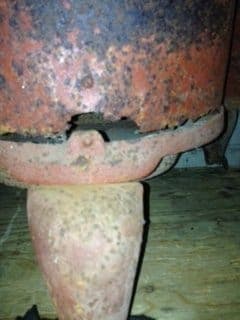
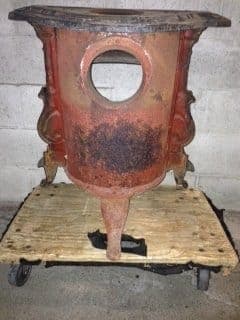
Any feedback is greatly appreciated as an earlier post mentioned, info on this is hard to come by, online anyways.
Sincerely
Adam
- Vancouver, B.C., Canada
December 5, 2014
![]() Hi Adam. The 3-legged design and the porthole front are really attractive! It would be great to have a lighted glass aquarium behind the porthole, or a banana plant growing out of the porthole, or something like that. Super cool looking; a design star would absolutely love this unique object!
Hi Adam. The 3-legged design and the porthole front are really attractive! It would be great to have a lighted glass aquarium behind the porthole, or a banana plant growing out of the porthole, or something like that. Super cool looking; a design star would absolutely love this unique object!
 But to try to get it airtight and safe enough to contain a hot fire inside your home? I absolutely wouldn't even try.
But to try to get it airtight and safe enough to contain a hot fire inside your home? I absolutely wouldn't even try.
Regards,

Ted Mooney, P.E.
Striving to live Aloha
finishing.com - Pine Beach, New Jersey
Ted can be retained for immediate
answers or long term project help
A. Very good info on stove polishes and pastes --
http://historiccookingschool.com/formula-for-stove-blacking-polish/
Hope it helps and good luck!
- Zagreb,Croatia
December 24, 2014
Ed. note: That page no longer exists, but the fabulous Wayback Engine on archive.org saved a copy for us: "10 Historic Formulas for Stove Blacking Polish" :-)
Q. Hi,
My Dover wood stove is pulling all the heat out the chimney. It draws so fast that it make a noise -- the oven doesn't want to heat up. It is built-in.
Thanks
Desi
- south africa
April 6, 2015
This meeting place welcomes Q&As, photos, history, & interesting tidbits.
Please engage with other posters
• When people show interest in each other's situations, the page quickly becomes a fun & informative learning experience for everyone !
• When people show no interest in other people's postings, and just post their own, it often quickly deteriorates into a string of unanswered questions 🙂
Q. I have a cast iron wood stove with several cracks. Is it dangerous to keep using it? What should I do please?
Jeannette speight- hira nelson, new zealand
April 15, 2015
Q. Hi what will it cost to get my stove restored? It is rusted, not sure how bad. Would like to use the stove?
Michelle Naidoo- Cape Town kuilsriver
June 3, 2015
Is my Majestic wood stove insulation asbestos?
Q. I have recently acquired a Great Majestic Wood Cookstove patented in 1900. There is a number on the clean out door below the oven "36468", which I assume could be the serial number of the stove. My inquiry is to determine if the insulation located on the back and oven side of the stove wall is asbestos. Is there a link or information regarding this concern? The insulation appears to have been removed at an earlier time but is still present under the cast iron grid. I have considered just removing the grid completely.
Thanks for your information!
buyer - High Rolls Mountain Park, New Mexico USA
October 18, 2016
A. You would need to send a sample to a lab for examination by polarized light or electron microscopy.
Is the insulation flaking, or is dust from it falling out? To do harm, asbestos needs to be what they call "friable." Frequently, the best thing to do is let it be, or coat it with some kind of stabilizing coating.

Dave Wichern
Consultant - The Bronx, New York
Dover wood stove
Q. About a Dover cast iron stove. It is a cook stove, with an oven! Do I clean it in the conventional way, with a wire brush, then with steel wool and stove polish, as described above?
Sean Higgins- South Africa
January 21, 2017
Original finishing of a findlay cast iron wood stove
Q. I currently own and use a Findlay - Universal 'B' wood burning cook stove. I have been told that it is in fantastic shape. Not knowing much about the stoves myself, I have no idea what is good or bad, condition-wise.
I am planning on doing some minor repairs to my stove in the spring/summer of 2018. I have acquired some spare parts and would like to clean up and refinish these parts as close to original as I can. Thus my main question... How was the original surface on the top of these cook stoves created?
I have met a guy that refinishes cast iron pans with 800 grit wet sand-paper with oil, then he bakes (cures) the pan with lard at 500 °F. He does the curing part 4 times. To me, it looks similar to the top of my stove, but me stove get way above 500 degrees.
I have heard of the high temp enamel, but something tells me that this will not last when I actually use the stove.
Any help would be appreciated.
Steve
Hobbyist / Handyman - Eganville, Ontario, Canada
October 26, 2017
A. Hi Steve. I don't know what finish Findlay applied and, although you're welcome to ask, we don't get a lot of good historical information on the subject posted here :-)
There are 3 finishes that I know of to put on a wood stove ...
1. The ideal one is porcelain/ceramic, which is much closer to melted glass than to paint. It's applied with a gun that melts ceramic grit at temperatures of thousands of degrees as it shoots it onto the metal. But there is no possibility of doing this yourself; finding someone who can will be difficult and it's very expensive.
2. The second option is high temperature paint. I've used this on my own wood stoves, but it's not going to be glossy like a ceramic stove top, it's just a matte black, and it's certainly not a cooking surface if that's what you had in mind.
3. The third option is stove polish, which other posters have suggested, but I don't have any hands-on knowledge of it.
Regards,

Ted Mooney, P.E. RET
Striving to live Aloha
finishing.com - Pine Beach, New Jersey
Ted can be retained for immediate
answers or long term project help
Q. I just acquired a cook top cast iron stove. I am not sure of the brand name or model. It has all of the pieces, etc., but is heavily rusted. I am experimenting with a water/citric acid
⇦ on
eBay
or
Amazon [affil link] solution to break down the rust and scrub it off with a wire brush then a nylon brush. Rinsed with fresh water and heat dried.
During the reassembly of the pieces I am considering to use brass fasteners. Is it ill-advised to use brass fasteners? I am looking towards the accent appearance as well as the durability.
- Jackson, Mississippi, USA
January 8, 2018
A. Hi Fred. For galvanic corrosion to occur requires metals with different electromotive potential, metal-to-metal contact, and a wet conductive solution to conduct ions. The latter requirement probably won't be present to any great degree in a controlled environment. I don't think it's much of a concern.
Regards,

Ted Mooney, P.E. RET
Striving to live Aloha
finishing.com - Pine Beach, New Jersey
Ted can be retained for immediate
answers or long term project help
Q. Hello. I am no expert in older wood stove restorations. I was given a very old rusty "grizzly" wood stove and followed you guys advice in this thread -- all very good advice by the way. I hit the thing with a wire attachment (drill) and prepped with a conditioning chemical. Question is, this thing has a lot of spaces on the inside that are impossible to reach and clean. should I be worried about the rust inside? is there harmful fumes associated with burning all that rust? there will be an exit pipe for the fumes and this stove will be utilized outside in my yard in a well ventilated area. Please let me know. Thanks in advance for the well intentioned advice. Omar.
Omar Romero- Riverbank, California United States
November 15, 2018
A. Hi Omar. I've heard of no dangers from fumes from rust. Obviously if the stove were rusted all the way through to where it had no structural integrity, and logs and coals could fall out, or flames could lick out, there could be a fire hazard -- but your stove does not sound like a problem.
Regards,

Ted Mooney, P.E. RET
Striving to live Aloha
finishing.com - Pine Beach, New Jersey
Ted can be retained for immediate
answers or long term project help
Q. I have Magic City, Ideal wood stove that I have used for many years. Now the sheet metal portion of the pot belly needs to be replaced. What metal do I need to use?
Gary C Floding- Mount Holly, North Carolina USA
December 11, 2018
A. Hi Gary. As far as I know you use plain low carbon hot rolled steel of the same thickness as the original. You probably won't find it in a hardware store but will have to order it from a steel distributor/warehouse like Ryerson Steel or Steel Warehouse.
Regards,

Ted Mooney, P.E. RET
Striving to live Aloha
finishing.com - Pine Beach, New Jersey
Ted can be retained for immediate
answers or long term project help
Q. Thank you, I contacted Ryerson steel, but, I don't know what gauge is best.
Gary C Floding [last name deleted for privacy by Editor]Retired - Mount Holly, North Carolina USA
A. Hi again, Gary. You need to measure the thickness from a remnant of the existing part, and look up what gauge that thickness is (I'm sure there are many charts on the internet, but
http://www.metaltrone.com/metalgauge-chart.pdf
was the first one that popped up for me). Good luck.
Regards,

Ted Mooney, P.E. RET
Striving to live Aloha
finishing.com - Pine Beach, New Jersey
Ted can be retained for immediate
answers or long term project help
![]() Hello Ted,
Hello Ted,
It measures about .045" (about 18 gauge), but, it's rusted and scaling. I think I'll go up to 16 gauge.
Thank you for your help, Gary.
Retired - Mount Holly, North Carolina USA
December 11, 2018
Q. I have a wood/coal burning Majestic cookstove. Years ago we removed the firebricks from inside to make moving it across country a little easier. Now I cannot remember where the firebricks were placed inside. Any suggestions on where firebricks should go? I feel like they may have been on top of oven under the large square griddle piece but I also have read that some use firebricks in bottom of oven.
Kathy Smith- Flemington West Virginia, USA
February 4, 2019
A. Hi Kathy. It may be neither here nor there, but my cast iron wood stove uses no firebrick at all, whereas my welded steel one used firebricks on the bottom, the sides, and the top.
As for the bottom, I remember that, because it made shoveling out the ashes a pain ... you might find the same recollection in your memory if you think about it. Or if you have some kind of grill the ashes pass through on the way to an ash collection box or drawer, obviously you can't have firebricks on the bottom blocking it.
As for the sides and top, there should be some sort of channels or angles that suggest where they go, sort of a back and front edge to support the bricks. Guessing is no substitute for researching it, but if no info is available ...
Regards,

Ted Mooney, P.E. RET
Striving to live Aloha
finishing.com - Pine Beach, New Jersey
Ted can be retained for immediate
answers or long term project help
February 2019
Q. Hello, I have a Sunny Heat Circulator wood burning stove that was purchased at Shapleigh Hardware in St. Louis. Dating back to who knows when.
I've had it for decades and I was thinking of restoring it.
After looking closely at it the other night, I notice (and yes, this wood burner is steel) there is a beautiful wood finish to it underneath its finish, I can find anything on it. I really don't know if it's a finish or just decades of baked on dust / dirt. I don't think it's paint. But under whatever it is looks to be a mahogany wood finish. Please see pics included.
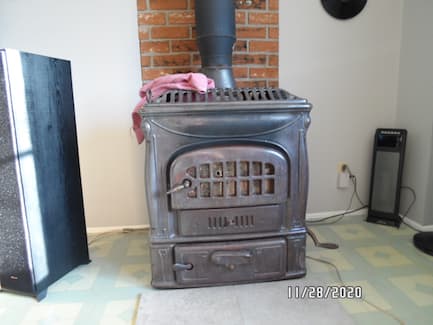
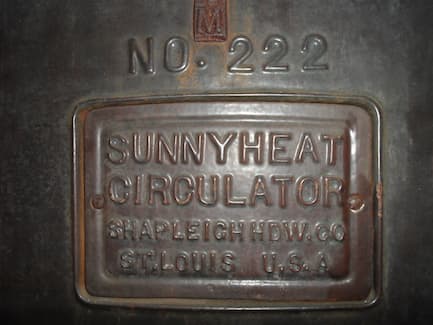
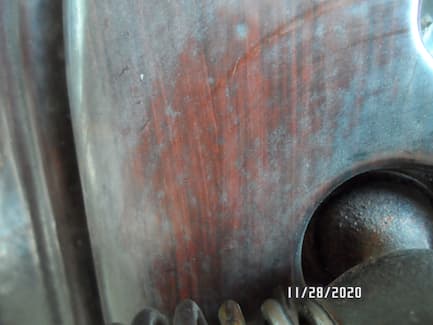
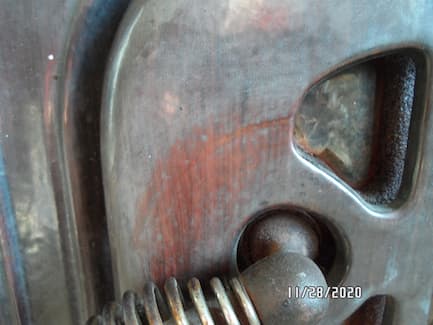
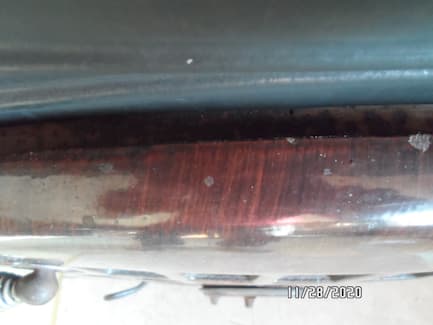
I have tried Windex Commercial Line ⇦ on eBay or Amazon [affil link] , 409, wax and silicone remover and finally lacquer thinner ⇦ on eBay or Amazon [affil link] Flammable! to remove that top finish, whatever it is. Any ideas?
Chris McgrailDecember 4, 2020
- Hillsboro, Missouri
A. Hi Chris. You can see here what just sunlight, let alone the heat of a wood stove, can do to paint, turning the red to greyish-white, and the white to greyish-black depending on exactly what dyes and pigments and metals it contains:

Although I suppose it's vaguely possible that someone put an antiqued wood grain finish on an unheated idle wood stove as a decorating feature, it strikes me as highly unlikely. More likely I think is that this is just a mix of rust, discolored paints and/or stove polishes. I think you can steel wool it to a more or less consistent finish and then apply either black stove paint or stove polish. Good luck.
Are you sure that legs aren't missing from that stove? I'm not so sure it's safe sitting directly on a linoleum-topped wood floor if that's what I'm seeing.
Luck & Regards,

Ted Mooney, P.E. RET
Striving to live Aloha
finishing.com - Pine Beach, New Jersey
Ted can be retained for immediate
answers or long term project help
Q. We have an antique Round Oak wood burning stove (Circa 1905). I was planning to remove all surface rust and then paint it satin black (Stove Bright) and re-nickel plate some of the parts.
My wife now tells me she doesn't like the "new" black and shiny nickel plated look and would prefer to retain the antique patina.
My question is: Are there products I can use after rust removal that will prevent the rust from returning (for several years at least) and retain the antique patina?
I know there are "rust converter
⇦ on
eBay
or
Amazon [affil link]
" products and perhaps clear coats (satin or matte) but don't know how they would work of look for this application.
Also, after I've removed the surface rust, I'm not sure that the metal will really look like. I might have to paint it anyway.
I'll appreciate any thoughts and suggestions.
- Raleigh, North Carolina
January 23, 2021
A. Hi Larry. Although I haven't used it myself (my wood stoves were newer and painted), many readers here think 'stove polish' rather than paint is the way to go, and have even included good directions.
Luck & Regards,

Ted Mooney, P.E. RET
Striving to live Aloha
finishing.com - Pine Beach, New Jersey
Ted can be retained for immediate
answers or long term project help
Q. Hi, I am in the process of restoring an old Fisher wood stove. This stove is steel plate, not cast iron. I've begun removing the rust with a wire wheel and would like to paint the stove but it seems that the previous owner used polish on it and it is extremely difficult to remove. Does anybody know the best way to remove stove polish?
Ethan Anderson- Spencer
September 14, 2021
Q. Hello!
I was given a Joutl #4 stove that I'd like to use outside. I'm curious if I can use some sort of heavy oil to keep it from rusting - like a cast iron pan, or is there a way to enamel it? I'm worried about fumes & wondering if I need to send it somewhere to have it professionally enameled or if there is some application I can do myself. Some things look cool when left to rust but I'm torn. Probably best to try and preserve it. Any ideas are greatly appreciated - Laura
Hobby - Colorado USA
December 13, 2021
A. Hi Laura. I doubt that cast iron pans would remain rust free for very long outdoors. But the corrosion resistance of paints is more dependent on good prep work than the particular paint. Wire brush it and steel wool it as thoroughly as practical, then apply a rust converter ⇦ on eBay or Amazon [affil link] (naval jelly for example), then two coats of stove paint or high temperature engine paint; touch it up when you see rust spots, and I think you'll be happy with it.
Luck & Regards,

Ted Mooney, P.E. RET
Striving to live Aloha
finishing.com - Pine Beach, New Jersey
Ted can be retained for immediate
answers or long term project help
A. Cast iron can be enameled but that is probably very expensive. Stove polish must be good option if your stove is protected from rain and snow. There are many formulas for stove polish on web. Hope it helps and good luck!
Goran Budija- Cerovski vrh Croatia
![]() Thank you, Ted! Thank you, Goran! I'll look into this :)
Thank you, Ted! Thank you, Goran! I'll look into this :)
- Ft Collins Colorado
December 16, 2021
Readers: Please see also thread 19039, Where & how to find information and parts for cast iron wood stoves.
Q, A, or Comment on THIS thread -or- Start a NEW Thread

